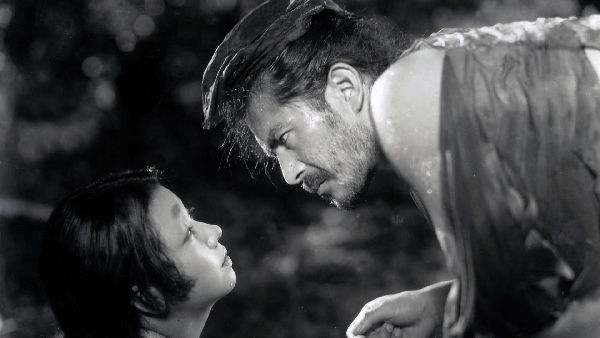Rashômon (1950) 
“The husband, the wife…or the bandit?”

Director: Akira Kurosawa
Cast: Toshirô Mifune, Machiko Kyô, Masayuki Mori
Synopsis: A heinous crime and its aftermath are recalled from differing points of view.
It’s highly unusual for a foreign language film to have as big an influence on global culture as Akira Kurosawa’s Rashomon, the film that first alerted the world to the quality of Japanese cinema in the immediate post-war years. Not only has the film been remade — or re-interpreted — on frequent occasions, but psychologists also speak of the Rashomon Effect, whereby observers of an incident can somehow come up with conflicting interpretations of what they have witnessed. Like most complex films it appears to be a relatively simple tale, but it’s a deceptively multi-layered narrative which leaves the audience constantly unsure about whether what they are seeing is a true account, a misinterpretation of events, or an outright lie.
The film opens with a city dweller chancing upon a woodcutter and priest in the ruined gates (Rashomon) to the equally ruined city of Kyoto — these characters, through whom the story will be told, literally stand on the threshold between the wilderness of the forest and the perceived safety of the city. Kyoto, however, is in ruins and offers little security, a fact reinforced by the way the city dweller casually rips planks from the gate in order to feed a meagre fire against a torrential downpour: the perception of security is just one of a series of illusions offered by the film. The woodcutter and priest are in shock, having returned from a court hearing into a murder in which they have heard radically conflicting versions of how and why the crime happened. At the insistence of the city dweller, the woodcutter and priest recount what has taken place.
On trial was the fearsome bandit Tajomaru (Toshiro Mifune), charged with the murder of a man (Masayuki Mori) and the rape of the man’s wife (Machiko Kyo). Tajomaru chanced upon them travelling through the forest, and was so taken with the woman’s beauty that he lured the husband to a clearing with the promise of a cache of swords, only to overpower and tie him up. Then, in front of the bound husband, he raped — or perhaps seduced — the wife. Three witnesses give evidence during the trial — and each gives a different version of events. Tajomaru claims that after the seduction, the wife argued that she could not live with two men knowing of their shame so one of them must die. So he released the husband so that they might fight a duel, and eventually overcomes him after a hard-fought encounter.
However, in her testimony, the shamed wife, who has now cloistered herself away in a nunnery, claims that after Tajomaru raped her he departed. She found husband’s dagger and can only remember standing over him when she passed out. When she regained consciousness, her husband was dead, with the dagger in his chest.
Finally, the murdered husband gives his version of events through a medium. He claims that, following the rape of his wife, she begged Tajomaru to take her away with him after first killing her husband. Tajomaru refused and released the husband, who then committed suicide. However, the woodcutter, who had initially claimed to have stumbled upon the scene after the murder took place, eventually confesses that he saw the whole thing, and that what actually took place was completely different to all three versions given at the trial.
Rashomon isn’t so much about the misperceptions of its witnesses, as the conflicting motives that colour the version of events that they choose to relate. The version each participant recounts is designed to show them in the best possible light under the circumstances. So Tajomaru paints himself as a bold and fearless fighter and seducer, the wife portrays herself as a helpless victim, and the husband describes himself committing a noble suicide rather than living a life of shame (or dying at the hands of a bandit). The woodcutter’s version of events paints an altogether less flattering picture — but, then, how reliable is his perception of what took place? Before recounting what he witnessed, the woodcutter admitted stealing the husband’s dagger, which makes him a thief, and therefore equally unreliable.
Kurosawa’s vision is ultimately a bleak one. The sin of ego leads us all to ‘change’ the truth in order to more closely correspond with our own self-image, which means that nothing in — or about — the world can be taken on trust. The film’s conclusion, in which the woodcutter undertakes to care for an abandoned baby might seem hurried and over-sentimental to some, but it actually conveys a quietly chilling message — that being aware of our failings does not necessarily make us better people. We are destined to follow the same pattern of self-aggrandisement, and will surely pass this flaw on to future generations.
(Reviewed 27th November 2012)
httpv://www.youtube.com/watch?v=ankoam7pqck
